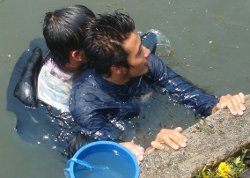Assisted Rescues
This lesson introduces assisted rescues, like wading rescue and swimming with an aid.
If a reaching or throwing rescue has been unsuccessful, or if a land based rescue is not possible, you may have to enter the water quickly. Keep your clothes on as you may need them in the rescue. Use a buoyant or rigid aid which you give to the casualty to hold onto. A rescue ring, empty cannister, item of clothing, or a torpedo buoy will work well.
Theory Lesson Plan
Primary Assessment: Conscious Casualty
Conscious, cooperative casualty, describes injury and cause.
Obstructed Airway: Conscious Casualty
Appearance and treatment of a conscious casualty with obstructed airway.
Recognition and Perception
From 3 different heights or positions, locate and describe a submerged object.
Shock
Primary assessment and emergency care for a casualty in shock.
Explain Defence Methods
Defence methods from front, side and back.
Practice
Head-Up Swim
Swim 25m head-up freestyle or breaststroke.
The point is to be able to keep an eye on your casualty.
Underwater Swim
Starting in the water, submerge and swim underwater for at least 10 meters.
Search
Head-up approach, surface dive 2 meters, swim 2-3 meters, recover an object and return
Object Support
Support a 2.5 kg object for at least 2 minutes in deep water.
Hold the object close to your chest.
Object Carry
Carry a 2.5 kg object 25 meters using lifesaving backstroke kick.
Hold the object close to your chest.
Practice Defence Methods
Defence methods from front, side and back.
Rescue: Non-contact with Buoyant Aid
Approach casualty with a buoyant aid across 20 meters, keep a distance of at least 3 meters.
Present the casualty with the aid and encourage to follow you to safety.
Perform appropriate follow-up
Rescue: Non-contact with Non-Buoyant Aid
Approach casualty with an aid across 20 meters.
Ask the casualty to hold on to the aid and tow back to the start point.
Assist the casualty out of the pool.
Assisted Lift Out
Assist a conscious casualty out of the pool.
Don't touch the casualty until you have a firm hold of the pool edge.
Avoid Direct Contact
DO NOT make direct contact with the casualty until you've reached the edge, unless they have difficulty to move. They may grasp you and get you into trouble.
Once you have hold of the pool side or the beach, assist the casualty out of the water and then climb out. Ask them to sit down and face away from the water. Treat for shock if necessary.
Sometimes the casualty only needs to be told to stand up.
They panicked when they fell into shallow water,
not realising they could stand on the ground.
This can happen to people who are not used to swim fully clothed.
They believe that the clothes will pull them down, which is incorrect.
They only slow them down.
Wading Rescue
Where a casualty is in shallower water this often requires a wading rescue. You should know at what depth you become too buoyant to carry out a wading rescue safely.
Wade in no more than chest deep, so you're not over-balanced by the buoyancy of the water. Thereafter it becomes a towing rescue. Practice this in different clothes with different buoyancy to gain experience.
Enter shallow water safely as near to the casualty as possible. Take with you a suitable buoyant aid or rigid pole. Use an item of your clothing if you have no rescue aid.
Encourage the casualty to hold on to the aid and follow you back to safety.
Stay clear of the casualty for your own safety.
Swim with an Aid
If the casualty is in deeper water you may have to swim towards them with a rescue aid like a rope, empty can, a stick, or your clothes. This requires skill and practice, so prepare for that.
Remember, your clothes can be used as a rescue tool, so don't discard them. Practice taking your top off in the water and present it to the casualty to hold onto. Get this move down to no longer than 5 seconds.

Assist your casualty to land when you have a firm hold on the edge.